III. Breaking through to a better future for all
The sobering picture of the Sustainable Development Goals being in reverse halfway to our 2030 deadline is a clarion call to the world to redouble our efforts to eliminate poverty and hunger, advance gender equality and overcome the triple planetary crisis of climate change, nature and biodiversity loss and pollution. Failure to heed that call will fuel greater political instability and displacement, further erode trust in public institutions, upend economies and lead to irreversible existential changes to our natural environment. Above all, it will cause immense suffering for current and future generations—especially among the world’s poorest and most vulnerable people and countries.
But we can turn things around. Although the overall picture is deeply concerning, the data also offers a glimpse of the possible, showing progress in a number of key areas from energy to Internet access and more. There is also ample evidence that the transformation demanded by the Goals is one of immense opportunity. And in the years since 2015, we have seen Governments, the private sector and the general public embracing the Sustainable Development Goals.
The Goals remain a truly inspiring and unifying compass, and transformative progress can be made even in the face of adversity. Furthermore, this generation is equipped with knowledge, technologies and resources unprecedented in history and can draw on a wide range of normative frameworks. Breaking through to a better future for all demands that we put this advantage to use to lift hundreds of millions of people out of poverty, advance gender equality, put our world on a low-emissions pathway by 2030 and secure human rights for all.
The 2023 Global Sustainable Development Report provides a synopsis of evidence showing that we can guide transformation toward sustainable and equitable outcomes. The sections below complement its findings and provide Member States with analysis and recommendations to unlock the rapid and deep transitions needed to deliver the Goals by 2030. The United Nations system will seek to mobilize support for a number of them, through a set of high impact initiatives in the lead-up to and following the SDG Summit.
World leaders should come together at the SDG Summit to deliver a rescue plan for people and planet centred around the following three major breakthroughs:

A. Equipping governance and institutions for sustainable and inclusive transformation
Delivering change at the speed and scale required by the Sustainable Development Goals demands more than ever before from public institutions and political leaders. It requires bold decisions, the transfer of resources from one sector to another, the creation of a new regulatory environment, the appropriate deployment of new technologies, the advancement of longer-term holistic perspectives, the mobilizing of a wide range of actors and the capacity to advance disruptive change while strengthening trust and social cohesion.1 Each of those dimensions presents challenges for political leadership and public governance systems. Together, they constitute a set of demands for which contemporary governance systems were not built. It is essential therefore to take action to equip governance systems for transformation.
Since 2015, Governments have responded to the Sustainable Development Goals in a variety of ways. Yet voluntary national reviews and research studies demonstrate that nationalization of the Goals has not yet had the necessary “normative and institutional impact, from legislative action to changing resource allocation”.2 The Goals must become more than a means to communicate change. They must become a guiding star that shapes national policies, budgets, institutions and long-term national development planning. They must become the core business of presidents and prime ministers, of parliaments and the private sector.
Incentivizing, steering and advancing transformation is complex and can often result in unintended consequences or trade-offs. Public institutions and public servants need to have capacities and strategies to continually revisit and adjust policy implementation in order to maximize benefits and capitalize on synergies while understanding trade-offs and identifying feedback loops, including by leveraging international human rights and labour standards. They also need to be able to work across sectors and contribute, including with budget alignment, to a whole-of-government approach to the Goals. The ability of institutions to steer and leverage digital technologies, in an inclusive and equitable manner, is also essential, as is a capacity to work in unison with the private sector and others to advance the public interest.
Localization, anchored on the principle of multilevel governance and multistakeholder collaboration, is a key approach to collectively propel us towards greater inclusion and sustainability. Local and regional governments have a key role to play in this process since 65 per cent of the Sustainable Development Goals targets are linked to their work and mandates.
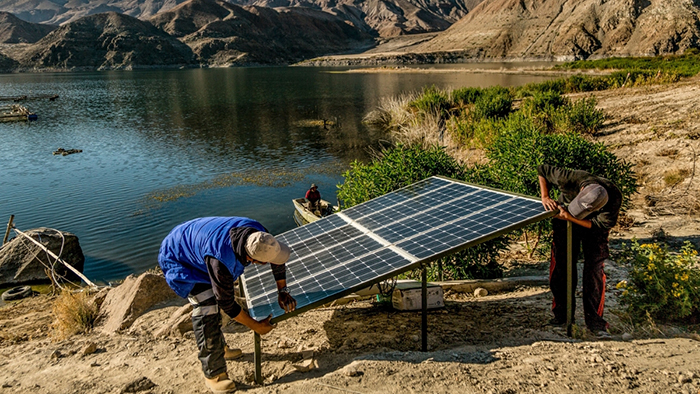
As the sphere of government closest to local communities, they are essential for responding to the erosion of the social contract and for protecting our societies amid intersecting global crises. Since 2018, the voluntary local review global movement has provided an unprecedented push towards localization. The more than 200 voluntary local reviews carried out to date have shed light on and raised the profile of local action as part of national action and international processes. In addition, the reviews have contributed to advances in all dimensions of localization of the Goals—from data innovation to planning and policy coherence, and to project development and financing. Even so, the resources of local and regional governments—financial, human and technical—remain limited across the globe, hindering their capacities to deliver basic services and drive development at the local level.
The private sector is a critical driver of productivity, employment and growth. Business leaders are increasingly acknowledging the necessity and urgency of taking sustainability factors into account to achieve long-term success. Businesses are making sustainability and climate-related commitments daily. They must be held accountable for those commitments, and they must deliver. Corporate governance models, incentive structures and operating practices must be adjusted to align with the objectives of sustainable development. Policies and regulations must facilitate long-term decision-making, include the pricing of externalities and phase out harmful subsidies. And we must see an improvement in the transparency and credibility of sustainability labels and ratings, ensuring that all efforts are made to eliminate rampant green-washing and Goals-washing.
Culture is a global public good and a critical enabler and driver of progress towards the Goals. Culture serves as a source of knowledge, values and communication, as a contributor to environmental sustainability and as a generator of economic activity and jobs.
Respect for cultural diversity and the diversity of religions and beliefs, as well as intercultural dialogue and understanding, are also crucial for strengthening social cohesion and sustaining peace. Culture and respect for cultural diversity, however, remain undervalued and underutilized in the push for Goals-related progress. Greater consideration of culture’s role in supporting the achievement of the Goals—including within relevant indicators—would generate an important boost for implementation of the Goals between now and 2030.
Access to timely and high-quality disaggregated data is essential. It can multiply the efficiency and effectiveness of domestic and development spending, generating a “data dividend” for implementation of the Goals. Yet many countries lack the resources and capacities necessary to respond to data demands and, as highlighted in section II above, there remain significant gaps in the geographic coverage, timeliness and disaggregation of Goals indicators. Domestic spending on data and statistics is low, and some 40 per cent of national statistics offices saw a drop in funding during the pandemic. There is little transparency around donor support in this area, and one study estimated that development cooperation spending on data had dropped by more than 20 per cent between 2018 and 2020. Greater use of new data sources and innovative approaches – including geospatial information, remote sensing, artificial intelligence and machine learning, crowd sourcing, qualitative methods, citizen-generated data and private sector data— represent new opportunities, although they are not without their own risks and challenges. Strong data governance, data literacy and data protection policies are essential, but today only about half of the least developed countries have such laws.3 Much more can be done to strengthen data ecosystems, and support from the United Nations and other international partners must also become more cohesive and effective.
Effective engagement with the global public and effective follow-up to Sustainable Development Goals commitments and implementation efforts are essential to understanding progress, boosting public ownership and identifying major objectives. By July 2023, 188 countries will have conducted voluntary national reviews—the central instrument for Goals-related follow-up and review at the global and national levels. Overall, countries have improved the preparation of their reviews, engaging stakeholders more systematically and combining multiple tools of analysis. Voluntary national reviews have also had a spill-over effect at the subnational level, with the growth of voluntary local reviews as a key example. With the Goals so far off track, and building on the lessons learned since 2015, it is time to take Goals-related follow-up to the next level. It is essential for our attention to shift from reporting national action to an international audience to strengthening national accountability for progress and transformation. This calls for a systematic inclusion of Goals-related implementation efforts in national oversight systems, for more independent evaluations of national implementation, for the greater involvement of scientists in monitoring and review, and for a fundamental rethink of the voluntary national review process.
Priority actions
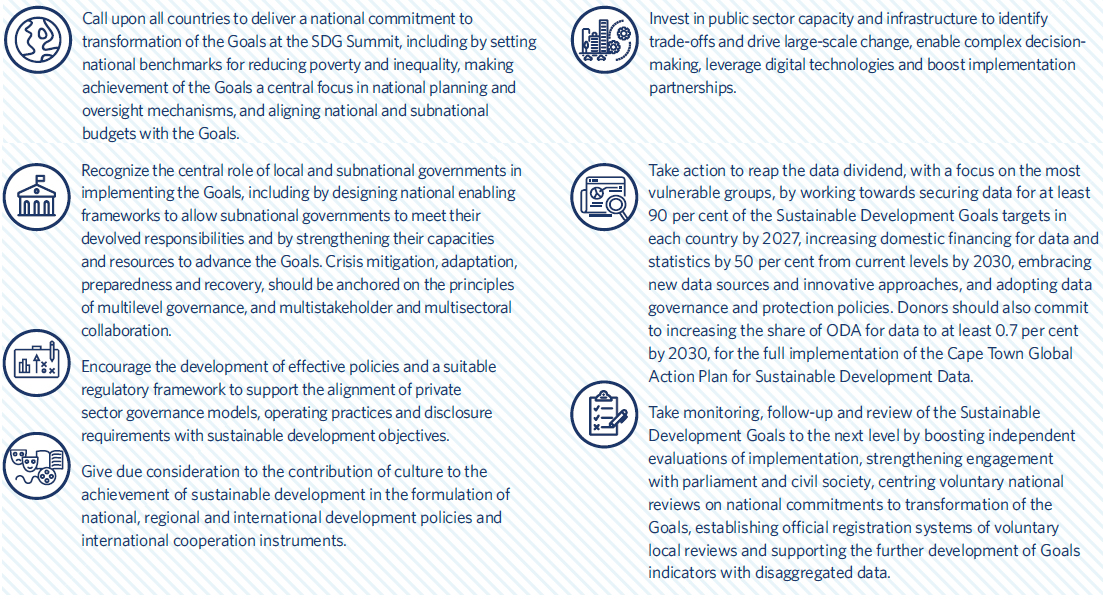
B. Prioritizing policies and investments that will drive just transitions and unlock progress across the goals
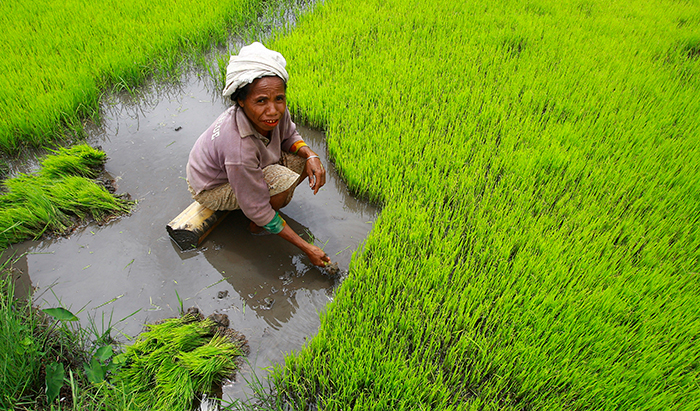
In 2015, the Sustainable Development Goals were agreed as an integrated and indivisible set of Goals and they cannot be achieved one at a time or in siloes. In the 2019 and 2023 editions of the Global Sustainable Development Report, the evidence-based case is made that transformation towards sustainable development will be possible only if actions address systems of goals and targets. Policy actions are needed to drive key transitions and to serve as multipliers that advance progress across the Goals. National priorities and contexts will determine the precise mix of policies and interventions, but combining actions and actors geared to leave no one behind with those that balance human well-being and the stewardship of nature can help build a holistic approach.
1. Close divides to leave no one behind
Recent crises have exposed unequal coping mechanisms and deepened divides across various dimensions of well-being. As shown in section II of the present report, above, the decades-long trend of narrowing global income inequality has reversed, more people are fleeing conflict than at any time on record, and the slum population is growing. The impacts of those reversals are felt most by women and girls and by vulnerable and marginalized populations, including persons with disabilities, migrants, refugees and internally displaced persons, and Indigenous Peoples.
The world must act to close gaps and improve the well-being of the people farthest behind and thus contribute to stability and resilience globally. Action in the areas below can also have multiplier impacts across the Sustainable Development Goals.
Provide shock-responsive, adaptive and universal social protection, and strengthen action to generate jobs for a just transition
Social protection and jobs creation and retention are the only refuge for the large segments of society with no financial buffers and are crucial tools for reducing and preventing poverty, in particular when crises hit. During the pandemic, many Governments rapidly expanded social protection coverage or benefits, often with digital tools, but many were one-time payments or short-term solutions.4 Most of those additional social protection and job retention measures were implemented in advanced economies with the resources to do so. In developing countries, many Governments now face the prospect of having to roll back those measures in response to compounding fiscal pressures.
In addition, social protection coverage often excludes those who need it the most, such as informal workers, in particular women.5 For instance, only 28 per cent of persons with significant disabilities have access to disability benefits globally, and only 1 per cent in low-income countries.6 The current global economic slowdown is also likely to force more workers to accept lower quality and poorly paid jobs that lack job security and social protection. The need for universal social protection and decent job opportunities will only grow as the transitions to green and digital economic systems accelerate and as demographic transitions unfold.
Despite the devastating impact of today’s cascading crises on social protection and livelihood opportunities, these shocks have also highlighted the opportunities for driving progress. Right now, there is a window of opportunity to cement some of the gains and learn from positive experiences, with impacts that can cut across the Sustainable Development Goals.7 Social protection that is dynamic in terms of both coverage and the means of distribution can bolster capabilities to weather crises. There is also a strong investment case for expanding social protection and supporting job creation: investing in the care economy, for example, could generate 280 million jobs globally, while investing in the green and circular economy could create 100 million jobs, both by 2030. The revenue from this job creation could fuel a virtuous cycle that can accelerate just transitions and create more resilient, inclusive and equitable societies for all. Despite high up-front costs in some cases, investing in these areas will yield long-term results that far outweigh immediate costs. Despite high interest rates, inflation and fragile debt situations, long-term, affordable financing to support social protection and decent job creation opportunities can and must be found. The United Nations Global Accelerator on Jobs and Social Protection for Just Transitions, launched in September 2021, is supporting the design and implementation of inclusive and integrated policies and investment strategies for decent jobs with social protection, to support just transitions for all. It also aims to establish national financing frameworks and mobilize public and private domestic and international resources, with the aim of expanding social protection to 4 billion people and creating 400 million new, decent jobs by 2030.
Priority actions
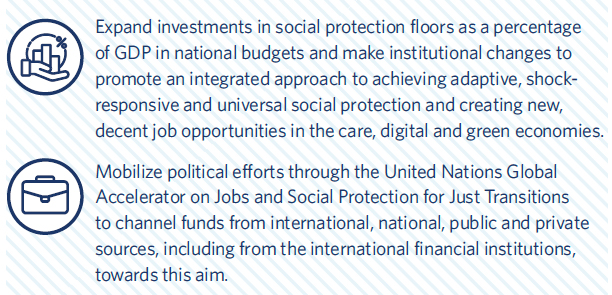
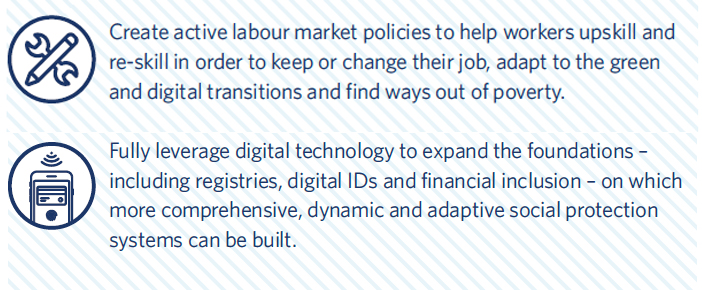
Invest in women and girls
Current rates of progress towards gender equality are set to leave half of the world’s population and the world’s workforce behind. Gender parity for labour-force participation had been slowing since 2009 – and it reversed in 2020.8 Women make about half as much as men do and carry a disproportionate share of care work, both paid and unpaid, which increased during the pandemic.9 Rates of violence against women were reported to have increased considerably during the pandemic. By one measure, GDP per capita would be almost 20 per cent higher if all gender employment gaps were closed.10 This demands a dismantling of discriminatory laws, a shake-up in the existing social structures and norms, and the use of special measures and quotas for the targeted investment in women.
The world’s population is also drastically changing. According to a recent United Nations study, greater parity in the labour force would do more to sustain economies in ageing, low-fertility societies than setting targets for women to have more children. Yet it is estimated that, globally, the number of unintended pregnancies every year is a staggering 121 million, or an average of 331,000 per day. Safeguarding access to quality sexual and reproductive health for all and instituting family-friendly policies are the best ways to ensure that people can achieve their individual reproductive goals and optimize their contribution to society.
Priority actions
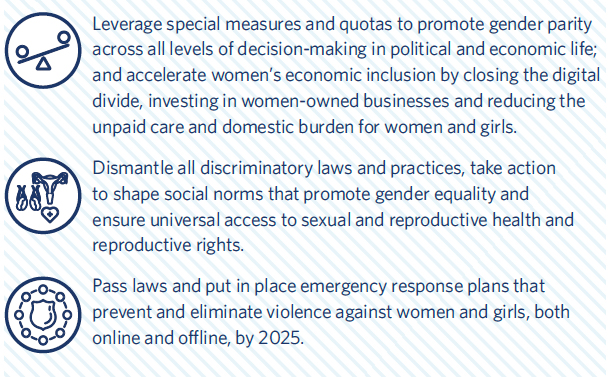
Make the digital transformation work for everyone
Persistent digital divides among and within countries stand in the way of widespread Goals-related progress and hamper the use of new data sources. These gaps should be tackled holistically, not just at a whole-of-government level but also at a whole-of-system level, with a focus on infrastructure, digital skills and inclusive environments, supported by the global development community.
Navigating the double-edged sword of digital transformation, managing digital risks and digital harms and leveraging the potential of technologies, requires investing in inclusive and accessible digital infrastructure to ensure meaningful connectivity for all. The large gaps in access to technologies, connectivity and infrastructure—as well as the poor accessibility of technologies themselves for groups such as persons with disabilities—have significant human rights and development implications. For instance, only one person in 10 in the world has access to assistive technology products and services.11 The proliferation of robotics, artificial intelligence, quantum computing, the Internet of things and cloud and mobile computing can support human well-being and the Sustainable Development Goals. Enhancing digital literacy and data literacy in and outside the public sector should focus on self-reliance and lifelong learning. Effective digital partnerships with the private sector and other stakeholders can produce applications to advance progress towards the Goals. The development by Member States of a global digital compact is under way and would be a step in the direction of making digital technologies work for the public good.
Priority actions
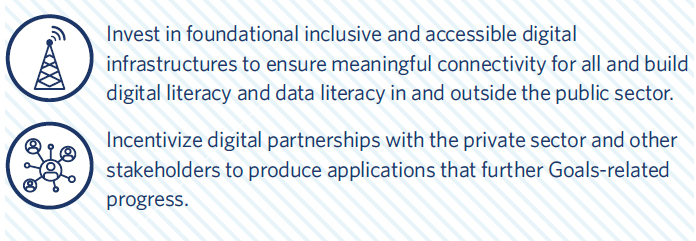
Adopt a life-course approach to essential services and urgently tackle the global crisis in education
Early and consistent investments in access to essential social services and social inclusion can improve the prospects for work and well-being later in life and are fundamental to a strong social contract. Interventions during early childhood and adolescence can prevent subsequent limitations and support socioeconomic mobility, while interventions in adulthood or older age can help individuals recover from past deprivations. However, systems today continue to take a fragmented approach. The limited focus on a life-course and intergenerational approach and inadequate access to training opportunities for older persons hamper their ability to continue working or find new employment.
Quality inclusive education is key to preparing today’s young people for high-skill jobs and is a major contributor to health and well-being, gender equality and climate mitigation.12 However, against the backdrop of pandemic-related lost learning, education today is in deep crisis. In low- and middle-income countries, the share of children living in learning poverty—unable to read and understand a simple statement about everyday life at age 10—could possibly reach 70 per cent,13 with children with disabilities and other marginalized groups suffering disproportionately.
As highlighted at the 2022 Transforming Education Summit, ending the current crisis and making education fit to tackle the world’s most pressing issues demands a sea-change in how Governments and the international community approach and invest in education. Recent analysis shows that almost $100 billion a year is needed to allow countries to meet their national benchmarks for achieving Goal 4. A forthcoming policy brief on transforming education will elaborate on this challenge as an input to the preparations for the Summit of the Future. The crisis in education is, however, a ticking time bomb. Urgent and focused action now will reap benefits for generations to come.
Priority actions

Invest in peace
The data in section II of the present report show that one quarter of humanity lives in a conflict-affected area. Development cannot wait in these areas. Investments in peace and sustainable development generate a virtuous cycle—with development gains addressing the drivers of conflict and inclusive peace enabling development priorities to expand.
Advancing the Sustainable Development Goals in conflict affected regions and those with humanitarian needs will break cycles of dependency and address the underlying drivers of vulnerability. It is vital to ensure that persons affected by instability, conflict or violence have access to services and protection, including the more than 100 million forcibly displaced people worldwide, of whom more than 32 million are refugees.14 Countries affected by conflict or humanitarian disaster need their partners and supporters to act coherently. They need peacebuilders, development practitioners and humanitarians who can see the bigger picture. They need partners who do not work in isolation. The United Nations must lead by example. All United Nations entities should work coherently and simultaneously to advance development priorities, meet humanitarian needs and build peace.
The New Agenda for Peace, being prepared for the Summit of the Future, will seek to reduce strategic risks by strengthening international foresight and capacities to identify and adapt to new risks and to focus on preventing conflict.15
Priority actions
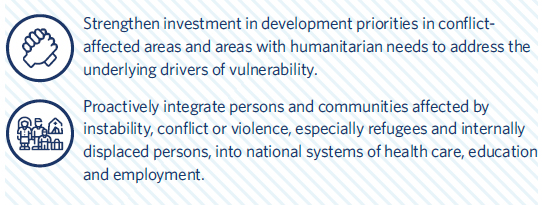
2. Leverage environment-human well-being synergies
Human well-being is integrally connected to the stewardship of nature and protection of the environment – the air, water, land and ecosystems that are foundations for life. Achieving the 2030 Agenda for Sustainable Development and the Paris Agreement depends on safeguarding these resources for sustainability, equality and justice. If the current trajectory towards climate change, biodiversity loss, pollution and the degradation of ecosystems goes unaddressed, progress on the Sustainable Development Goals could unravel, exacerbating hunger, poverty, conflict, natural disasters and public health emergencies. However, acting now in the below areas could boost progress across the Goals and support the promise to leave no one behind.
Accelerate access to energy for all and the shift to renewables
Access to electricity in developing countries has increased, even during the current period of crisis, while a lack of access to clean cooking solutions remains stubbornly persistent. The pace of progress needs to accelerate, along with the reliability and affordability to reach everyone. This needs to happen while also ensuring the transition to renewable energy systems, supported by measures to increase energy efficiency.
Immediate, deep, rapid and sustained reductions in the greenhouse gas emissions of the energy sector is imperative in order to preserve the 1.5°C goal of the Paris Agreement, since energy accounts for more than two thirds of global greenhouse gas emissions.16 Accelerating the renewables revolution is our best hope of ensuring energy security, affordability, access and independence, while keeping the 1.5°C target alive. At the same time, the transition to renewables must be proactively managed to minimize social disruption and maximize the many socioeconomic benefits, including economic growth, poverty eradication and job creation during the transition. Using solar and wind power to replace coal could save $23 billion a year.17 The transition would create 24 million to 25 million new jobs, far more than the 6 million to 7 million jobs that will be lost.18
Priority actions

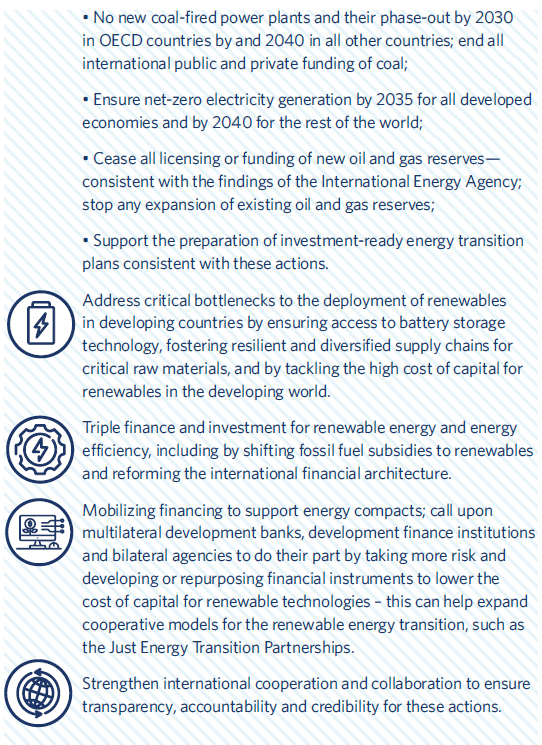
Secure food, water and sanitation systems
Business-as-usual approaches are neither protecting the right to food and water for a growing population nor safeguarding the environment to sustain and secure the provision of these resources. Efforts to address hunger and food security are falling behind, even as direct greenhouse gas emissions from agriculture are projected to increase by 6 per cent during the next decade.19 Furthermore, access to clean water and water management are at risk as climate disasters increase and several regions face severe water scarcity. Low access to sanitation and hygiene remains a major and urgent challenge with devastating impacts on health, human dignity and the situation of women and girls. Rapid urbanization intensifies these challenges but also offers opportunities to build more resilient, cost-efficient and inclusive cities. The nexus of food, water, sanitation and environment sustainability must factor into development pathways holistically and coherently, with adequate human, technological and financial resources.
Since the 2021 Food Systems Summit, 117 countries have developed national food system transformation pathways – with some having started implementing their pathways while others need technical and financial assistance to move forward. System complexities are being built into emerging initiatives using data from socioeconomic models and biophysical models. The United Nations Water Conference, held in March 2023, mobilized new commitments to solve the water and sanitation crisis, with the potential to generate dividends across the Sustainable Development Goals. For every dollar invested in water and sanitation, there is a $4.30 return in reduced health-care costs for individuals and society.20
Priority actions

Protect biodiversity and natural resources
The environmental resources that sustain life are under threat, with trends moving backward since the adoption of the 2030 Agenda. Yet more than half of the world’s GDP is highly or moderately dependent on nature.21 Some 1.6 billion people’s livelihoods depend on forests, where the highest levels of terrestrial biodiversity are found, making sustainable land management critical to human well-being and poverty reduction. Another 680 million people live in coastal megacities. Many coastal dwellers rely on aquaculture for their livelihoods, and nearly half the world’s people depend on fish for protein. Striking a better balance with nature is also a health priority. Land degradation and habitat fragmentation drive humans and wildlife into closer contact, reducing biodiversity and increasing the risk of future pandemics through the spread of zoonotic disease.
Protecting nature is also crucial for climate action, as forests and oceans help mitigate climate change by absorbing carbon dioxide. Oceans absorb one third of carbon emissions released into the atmosphere, but increased absorption of carbon dioxide leads to ocean warming and acidification, ice-melting, sea-level rise and marine heatwaves, threatening the natural marine ecosystems and populations reliant on oceans for their lives and livelihoods.
The recent adoption of the Kunming-Montreal Global Biodiversity Framework at the culmination of the 15th United Nations Biodiversity Conference represents a landmark agreement by Governments to guide actions and funding to safeguard nature, protect indigenous rights and sustainably manage other critical resources by 2030. The 2018 Regional Agreement on Access to Information, Public Participation and Access to Justice in Environmental Matters in Latin America and the Caribbean can facilitate implementation of global sustainable development agreements.
Priority actions
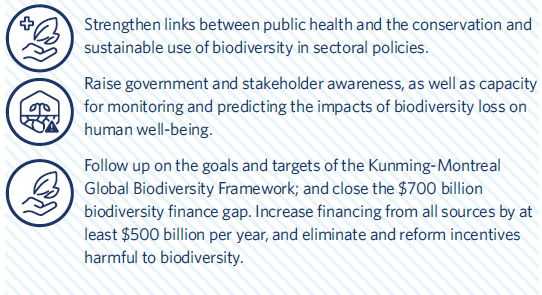
Prevent new and reduce existing disaster risks
COVID-19, conflict and climate disasters have shown just how vulnerable Goals-related progress can be to shocks. Systematically integrating risk considerations into planning for the 2030 Agenda can reduce the consequences of shocks, especially for the vulnerable, and the likelihood of crises. It is also important to acknowledge that actions in one system can create or reduce risks for another, as hazards cascade across systems.
Countries can shock-proof Goals-related progress by strengthening risk management governance and adopting a multi-hazard and multisectoral approach to dealing with pandemics or climate change that can disrupt societal and economic networks. The integration of disaster risk reduction with climate, sustainable development and humanitarian action is also needed, shifting the balance from responding to investing. The United Nations policy brief on an emergency platform to strengthen the international response to complex global shocks, an input into the preparations for the Summit of the Future, outlines how a more predictable and structured response can help mitigate the risks to the most vulnerable countries.
Strengthening disaster risk resilience requires leadership at the highest level of government, engagement from all sectors and multistakeholder participation. My initiative to ensure universal coverage of multi-hazard early warning systems can ensure minimal loss of lives and livelihoods when disasters strike. Collaborating to develop new tracking systems to record and analyse hazardous events and disaster losses and damages can also help. Greater investments in capacity-building and transformative action on investments to accelerate Goals-related progress pave the way for greater strategic foresight and the implementation of national disaster risk reduction financing.
Priority actions
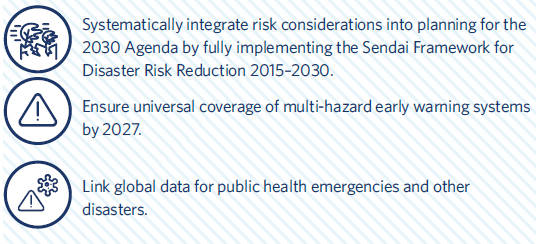
Securing a surge in Sustainable Development Goals financing and an enabling global environment for developing countries

Rising inflation, unsustainable debt burdens, the COVID-19 pandemic, and the impacts of the war in Ukraine on the costs of food and energy and financing have significantly reduced countries’ fiscal space, undermining their ability to invest in recovery efforts. Despite increased support from the international community to developing countries, these efforts have remained inadequate, exacerbated by an international financial system that is not fit for purpose and that remains plagued with systemic and historic inequities.
In addition, developing countries struggle to gain equitable access to the global trading system and to the benefits of new technologies and the fruits of science and innovation—all of which continue to favour those countries that have benefitted historically from protectionism and global resource extraction.
To reverse course and turbocharge the Sustainable Development Goals, it is essential for countries to have the resources they need at scale to invest in both their immediate recovery and in long-term sustainable development outcomes, including climate action. This requires a two-pronged approach that aims to secure a surge in Goals-related financing, while simultaneously reforming the international financial architecture to make it resilient, equitable and accessible for all. It is also critical that developing countries have better access to global trade, science, technology and innovation.
Deliver a Sustainable Development Goals stimulus and reform the international financial architecture
To secure a surge in Goals-related financing in the short term, the Sustainable Development Goals stimulus plan calls for an additional $500 billion per year in financing for sustainable development, to be delivered through mutually reinforcing concessional and non-concessional finance.
The Sustainable Development Goals stimulus puts forward three main areas for immediate action: (a) tackle the high cost of debt and rising risks of debt distress, including by converting short-term, high interest borrowing into long-term (more than 30-year) debt at lower interest rates; (b) massively scale-up affordable long-term financing for development, especially through multilateral development banks and by aligning all financing flows with the Goals; and (c) expand
contingency financing to all countries in need. The Sustainable Development Goals stimulus also aims to ensure that resources are invested in the areas needed to secure the Goals and just transitions. Countries should align all forms of finance with the Goals, using tools such as Goals-aligned integrated national financing frameworks.
Urgent action is also needed to prevent tax evasion and avoidance and illicit financial flows, to boost international tax cooperation and to strengthen national fiscal capacities for domestic resource mobilization.22 All countries can use globally agreed concepts and tested methods to curb illicit finance. Making budgets more credible and increasing the efficiency of budget execution are also critical.
While the Sustainable Development Goals stimulus can be achieved within the confines of the current financial architecture, adequate long-term financing requires the reform of the international financial architecture in order to overcome the major structural barriers that predominantly serve wealthy countries and individuals. This calls for delivering on the Addis Ababa Action Agenda and other international frameworks. It also calls for ambitious efforts in order to: (a) go beyond GDP when determining access to concessional finance; (b) create new financing models for global public goods; (c) change the business models of multilateral development banks, aligning their mandates and operational models with the Goals; (d) strengthen the global financial safety net; (e) improve debt ratings; and (f) create an effective sovereign debt workout mechanism. And it calls for reforming the international financial architecture and global economic governance structures to make them more inclusive and representative. These and other areas will be elaborated in forthcoming policy briefs on reforming the international financial architecture and developing metrics beyond GDP, which will be part of a series of crucial inputs to Member States as part of preparations for the 2024 Summit of the Future. The International Conference on Financing for Development in 2025 will provide a clear pathway to secure progress on the full range of issues addressed in the Addis Ababa Action Agenda.
International and domestic private investment in emerging and developing economies must be scaled up. The Global Investors for Sustainable Development Alliance has put forward a definition of sustainable development investing to guide the private sector. It calls for sustainable development investing in ways that contribute to sustainable development, using the Sustainable Development Goals as a basis for measurement. Attracting such investment at scale requires strong institutions and a conducive regulatory and operating environment. Transparent de-risking mechanisms and guarantees around key risk markers must be scaled up to secure greater private investment in the Goals without saddling Governments with even more debt.
Priority actions


Harness trade to work for the Sustainable Development Goals
Trade is a critical driver of economic growth, job creation and poverty reduction in developed and developing countries alike. But to realize the benefits, developing countries must overcome various barriers and challenges that prevent their integration in regional and global value chains and investment networks.
One major obstacle to trade is high transport costs, which can make goods uncompetitive in global markets. Developing countries also face price fluctuations for primary commodities, which can lead to volatile and unpredictable export earnings. Unpredictable supply chains hinder the timely delivery of intermediary and final goods, a problem clearly illustrated during the COVID-19 pandemic. Cumbersome customs processes and protectionist policies further impede trade flows. Moreover, the shift towards knowledge-intensive services—such as professional services, government services, information technology services and telecommunications—has highlighted the importance of digital infrastructure and literacy. Data flows, which have been growing at close to 50 per cent annually between 2010 and 2019, make digital infrastructure fundamental.
Despite those challenges, several recent developments have generated new momentum for leveraging trade for the Sustainable Development Goals. The COVID-19 pandemic prompted emergency policies to remove trade and financial roadblocks to accelerate the delivery of vaccines, therapeutics and diagnostics. The Initiative on the Safe Transportation of Grain and Foodstuffs from Ukrainian Ports has helped countries to withstand shocks to trade caused by the war in Ukraine. The African Trade Exchange Platform is helping to address food, fuel and fertilizer shortages in developing countries. After more than two decades of negotiations, WTO members reached the landmark and novel multilateral Agreement on Fisheries Subsidies. The global system of trade preferences among developing countries is only one ratification away from entry into force—a move that would allow preferential tariff treatment, generating shared welfare gains of $14 billion.
To maximize the role of trade in achieving the Sustainable Development Goals, it is crucial to strengthen the multilateral trading system and align it with the Goals. This system should be universal, rules-based, open, non-discriminatory and equitable. At the same time, developing countries need support to build productive capacity and infrastructure to connect
with regional and global production and supply chains, by meeting environmental requirements and using digital trade infrastructures for e-commerce. Approaches should be inclusive of micro, small and mediumsized enterprises, and women-owned enterprises, with progress measured by sex-disaggregated trade and business statistics. Developing countries also need the policy space to implement coherent industrial, innovation, trade and investment policies to mainstream trade into national and sector strategies in support of the Goals. Collaboration at the multilateral level is also essential to address vulnerabilities in supply, transport, distribution chain infrastructure, and trade finance for micro-, small and medium-sized enterprises to reduce disruptions from climate change, conflict and future pandemics.
Priority actions:
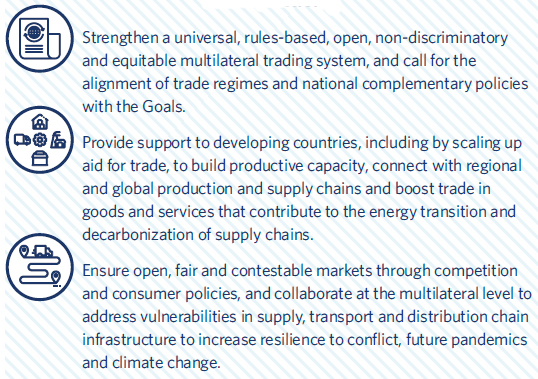
Revolutionize science, technology and innovation capacities and exchanges
The capacity for humanity to use science, technology and innovation to confront crises in transformative ways, and for science, technology and innovation to deliver for the public good, was clear during the pandemic. The potential for science, technology and innovation to be applied to the Sustainable Development Goals is vastly untapped, and institutional and other barriers that stand in the way of science, technology and innovation progress must be recognized and lowered.
Increasing funding for Goals-related research and innovation on underlying social issues, social policy and grass-roots innovations, in particular in low-income countries, would provide the data, evidence and analytical tools to better inform actions for the Goals. Access to knowledge, technology and opportunities to contribute to science, technology and innovation development must be improved, including through strengthened technology transfer. Creative solutions for removing paywalls and sharing knowledge need to be scaled up, and public-private partnerships should boost digital infrastructure investments, but Governments have to ensure that appropriate regulatory frameworks are in place. Applying science to solve complex interlinked challenges calls for cross-disciplinary collaboration. A strong science-policy-society interface can build trust in science and evidence, as emphasized in the 2023 Global Sustainable Development Report. Trust in the science behind COVID-19 vaccines and climate change, for example, needs to be built through open and inclusive deliberations for individuals to use technology solutions and change behaviour.
Priority actions:
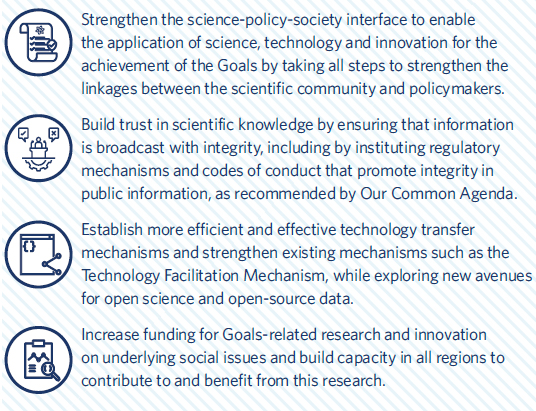
Maximize the contribution of multilateralism and the United Nations development system to support acceleration of the Sustainable Development Goals
The above sections of the present report have demonstrated the degree to which multilateralism can support national action to achieve the Goals. Our Common Agenda includes a wide range of recommendations to that end, many of which are already under way.
The preparations for the Summit of the Future in 2024 provide a critical opportunity to leverage multilateralism’s capacity to support acceleration of the Goals and to sustain Goals-related progress by planning for and tackling emerging challenges and addressing gaps and weaknesses in the international architecture that are undermining efforts to achieve the 2030 Agenda. Further action in a number of areas in the context of the Summit of the Future – including a global digital compact, progress on reforms of the international financing architecture, measuring progress by going beyond GDP, ensuring that governance systems protect the rights of future generations and facilitate the active engagement of young people in decision-making, and transforming education to better prepare learners of all ages for the future – will further support acceleration of the Goals.
The United Nations development system is the strongest affirmation to people across the world of the commitment of the United Nations to the Sustainable Development Goals. In 2018, the General Assembly, in its resolution 72/279, embraced an ambitious reform of the United Nations development system to ensure that Member States had the transformative support required to advance their national Goals-related ambitions. At the midpoint of the Goals, the United Nations development system is unquestionably better positioned to support Member State action for delivery of the Goals. The new generation of United Nations country teams and the reinvigorated resident coordinator system are better aligning with national priorities, shifting to higher-scale programmes and policy support. Resident Coordinators are convening in unprecedented ways to help Governments harness means of implementation, in particular financing. Some foundational challenges remain, in particular the insufficient implementation of the funding compact, especially in relation to core and pooled funding; an underfunded and unsustainably funded resident coordinator system, continued challenges in mobilizing support on economic and financial issues, and insufficient integration from the regional to national levels. If the United Nations system is to step up in the second half of the Goals, then targeted and determined action is needed in these areas.
Priority actions
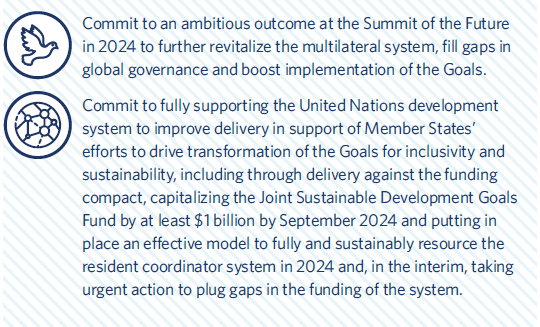
IV. Looking ahead: towards a rescue plan for people and planet
The world has been rocked by a series of interlinked crises. Together, these have exposed fundamental shortcomings in the business-as-usual approaches to sustainability, including the vulnerability and fragility of progress, growing inequalities, the life-long impacts of adverse events, increasing threats of irreversible change, risks of ignoring interlinkages, and the geographically imbalanced distribution of global assets for achieving sustainable development.
Tepid responses will not suffice for the millions of people living in poverty and hunger, the women and girls with unequal opportunities, the communities facing climate disaster or the families fleeing conflict. We need a full-fledged rescue plan for people and planet. There are no excuses not to be ambitious. Never before have we had such an abundance of knowledge, technology and resources to succeed in ending poverty and saving the planet. Never before have we carried such a responsibility to pivot to a bold set of actions.
At the SDG Summit, we must match that abundance and responsibility with global, national and local commitments to deliver the finance, galvanize the leadership and restore the trust that together will put us on course to achieve the Goals by 2030.
1 See www.idlo.int/system/files/event-documents/2021_sdg16_conference_report_05072021.pdf.
2 See www.nature.com/articles/s41893-022-00909-5.
3 See https://unctad.org/page/data-protection-and-privacy-legislation-worldwide.
4 Maya Hammad, Fabianna Bacil and Fábio Veras Soares, Next Practices – Innovations in the COVID-19 social protection responses and beyond (UNDP, 2021), available from https://socialprotection.org/discover/publications/next-practices-innovations-covid-19-social-protection-responses-and-beyond.
5 See www.wiego.org/resources/long-economic-covid-worlds-working-class-infographic.
6 United Nations, “Policy brief: a disability-inclusive response to COVID-19” (May 2020), available at https://unsdg.un.org/sites/default/files/2020-05/Policy-Brief-A-Disability-Inclusive-Response-to-COVID-19.pdf.
7 International Labour Organization, Food and Agriculture Organization of the United Nations and United Nations Children’s Fund (UNICEF), UN collaboration on social protection: Reaching consensus on how to accelerate social protection systems-building (Geneva, 2022), available from https://socialprotection.org/discover/publications/un-collaboration-social-protection-reaching-consensus-how-accelerate-social.
8 World Economic Forum, Global Gender Gap Report 2022 (Geneva, 2022), available from www.weforum.org/reports/global-gender-gap-report-2022/.
9 OECD, “Caregiving in Crisis: Gender inequality in paid and unpaid work during COVID-19” (2021), available at www.oecd.org/coronavirus/policy-responses/caregiving-in-crisis-gender-inequality-in-paid-and-unpaid-work-during-covid-19-3555d164/.
10 See https://openknowledge.worldbank.org/handle/10986/37062.
11 See www.who.int/health-topics/assistive-technology#tab=tab_2.
12 Cordero EC, Centeno D, Todd AM (2020) The role of climate change education on individual lifetime carbon emissions. PLoS ONE 15(2): e0206266. https://doi.org/10.1371/journal.pone.0206266.
13 United Nations Educational, Scientific and Cultural Organization (UNESCO), UNICEF and World Bank, The State of the Global Education Crisis: A Path to Recovery (Washington, D.C., Paris and New York, 2021), available from https://documents1.worldbank.org/curated/en/416991638768297704/pdf/The-State-of-the-Global-Education-Crisis-A-Path-to-Recovery.pdf.
14 See www.unhcr.org/refugee-statistics/.
15 See https://dppa.un.org/en/new-agenda-for-peace.
16 See www.iea.org/data-and-statistics/data-tools/greenhouse-gas-emissions-from-energy-data-explorer.
17 International Renewable Energy Agency, Renewable Power Generation Costs in 2019 (Abu Dhabi, 2019), available from www.irena.org/publications/2020/Jun/Renewable-Power-Costs-in-2019.
18 ILO, World Employment and Social Outlook 2018: Greening with jobs (Geneva, 2018), available from www.ilo.org/global/publications/books/WCMS_628654/lang--en/index.htm.
19 See www.oecd-ilibrary.org/docserver/f1b0b29cen.pdf?expires=1678719176&id=id&accname=guest&checksum=D46813AB4B74489CA8839EE6843A7CF3.
20 See https://news.un.org/en/story/2014/11/484032#:~:text=For%20every%20dollar%20invested%20in,United%20Nat ions%20World%20Health%20Organization.
21 Intergovernmental Science-Policy Platform on Biodiversity and Ecosystem Services, Global assessment
22 https://factipanel.org/docpdfs/FACTI_Report_ExecSum.pdf.

